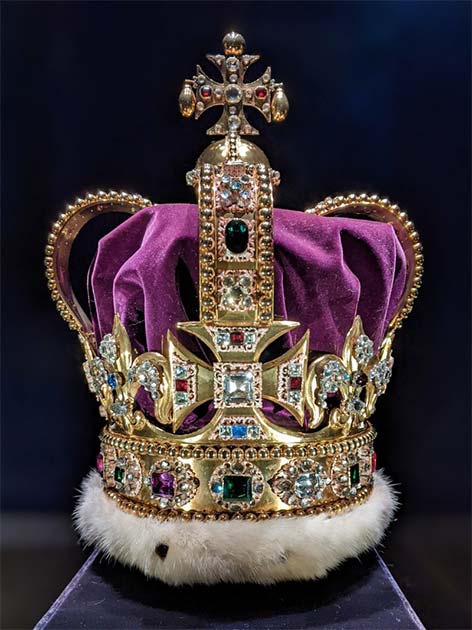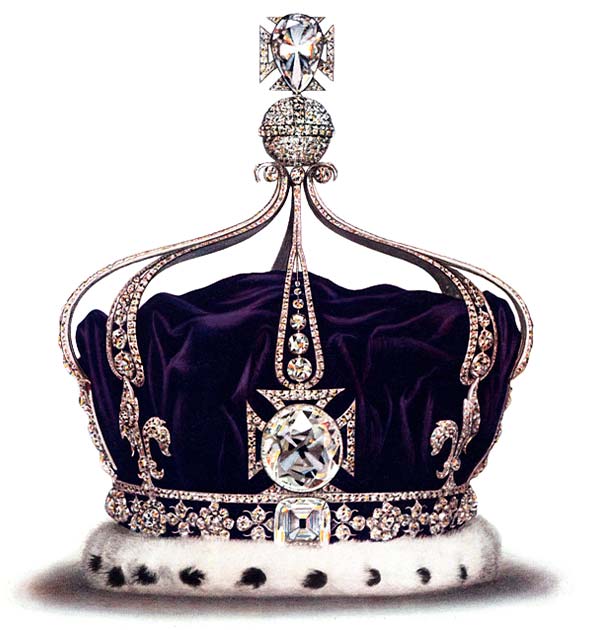
Coronation of King Charles III Utilized Crown Jewels and Sacred Royal Regalia
Citizens of the United Kingdom will be witness to a rare and special moment on Saturday, May 6, when the former Prince Charles is official crowned as King Charles III. On display and in use at the coronation ceremony will be multiple items from the Crown Jewel collection, along with other sacred objects designated as the royal regalia. Most of these incredibly valuable and historically significant items have not been seen by the public since Queen Elizabeth II’s coronation 70 years ago, and it may be a few decades more before they are put on display again.
The coronation extravaganza will complete an historic transfer of a title (king, or monarch) that has been held by hundreds of sovereign rulers across the world for more than 4,000 years. While being the King of the United Kingdom and the 14 Commonwealth realms is no longer associated with absolute political power, or any political power at all for that matter, people still honor and respect the monarchy and the person who holds the title of king or queen.
In recognition of the historical meaning of the coronation ceremony, the Crown Jewels, royal regalia and associated objects will be temporarily removed from the Royal Trust collection and transferred to Buckingham Palace and Westminster Abbey. What follows is a list of some of the incredibly valuable objects that will included in one way or another in these exalted proceedings.
- Thomas Blood: The Man Who Stole the Crown Jewels
- King Charles III Modernizes Coronation and Strips Back Ancient Traditions

St Edward's Crown, the centerpiece of the Crown Jewels of the United Kingdom. (Public Domain)
St. Edward’s Crown
The centerpiece of the crown jewels is St. Edward’s Crown, which will be placed on King Charles’s head at the climax of the coronation ceremony. This heavy solid gold crown is adorned with a colorful arrangement of glistening semi-precious stones. It is trimmed with purple velvet and ermine, and includes four crosses and four fleurs-de-lis.
St. Edward’s Crown was commissioned in 1661, for the coronation of the King Charles II. Its name can be traced to the last Anglo-Saxon king of England, Edward the Confessor, who is believed to have worn a headpiece that resembled the currently existing crown.
While Charles III will wear the crown for a while during the upcoming ceremony, that will be the only time during his reign that he will actually have it on his head. This is undoubtedly a blessing for the king, since the large golden headdress weighs nearly five pounds (two kilograms).
- Killer Queens: 5 of Ancient History’s Most Outstanding Female Rulers
- King Charles III’s Coronation: A 900-Year-Old Ceremony in the Modern Day
Imperial State Crown
In addition to St. Edward’s Crown, King Charles III will also be wearing the more modern Imperial State Crown at different points during the coronation ceremony.

Britain’s Imperial State Crown (made in 1937 with alterations in 1953); picture taken at the exhibition of the Crown Jewels of the United Kingdom inside the Jewel House (Waterloo barracks, Tower of London (CC BY-SA 4.0)
Made to be worn at special public events, such as the state opening of Parliament, the Imperial State Crown was made for the coronation of King George VI (the new king’s maternal grandfather) in 1937. It weighs about half as much as St. Edward’s Crown but is just as amply adorned, as it features an glittering array of diamonds, sapphires, pearls, emeralds and rubies. This crown’s crown jewel, so to speak, is the Cullinan II diamond, which was cut from the largest diamond ever discovered.

Queen Mary’s Crown will be placed on Queen Camilla’s head when she is coronated at the same ceremony. (Public Domain)
Queen Mary’s Crown
Charles II will not be the only person wearing a special headpiece at the coronation ceremony. As the new queen consort, his wife Camilla will be wearing Queen Mary’s Crown, which features a dazzling collection of 2,200 small diamonds. In order to pay tribute to her late mother-in-law, Queen Elizabeth II, Camilla arranged for several larger diamonds from the queen’s personal collection to be added to the crown as well.
One object that will no longer be sewn into Queen Mary’s Crown is the Koh-i-Noor diamond, which originally comes from India and was seized by the British East India Company in 1849. This diamond has now been removed, reflecting changing sensibilities about the British Empire and its colonial activities.
This crown was commissioned by the wife of King George V, Queen Mary, for her coronation as queen consort in 1911. This will be the first time in almost 300 years that a previously existing crown has been used to anoint a queen or king consort.
Migration The Scepter of the Cross and the Sovereign’s Orb
There will be several scepters on display at the coronation, including the Scepter of the Cross, which symbolizes the monarch’s power and commitment to good governance. This heavy rod-shaped object is made from gold and decorated on each end by a variety of precious and semi-precious stones. It features a special mounting attachment made for the priceless Cullinan I or Star of Africa , the largest translucent diamond in the world.
The Sovereign’s Orb will also be included in the ceremony, and like the Scepter of the Cross its purpose is to symbolize the king’s special and sacred powers. Also like the Scepter this shining golden ball is adorned with an impressive set of precious and semi-precious stones.
As is the case with many of the items that will be worn or displayed at the upcoming ceremony, the golden orb and scepter were made in 1661, for the coronation of King Charles II.
Two Royal Carriages
The new king and his queen consort will travel from Buckingham Palace to Westminster Abbey inside the horse-drawn Diamond Jubilee State Coach. Having been built for Queen Elizabeth II in 2014, the Diamond Jubilee includes air conditioning and automatic windows, and has hydraulic stabilizers to prevent it from swaying as it is pulled along.
When they return to the palace after the ceremony, the pair will ride in the more traditional Gold State Coach, which has been in use since 1762. This densely constructed golden carriage weighs four tonnes and takes eight horses to pull. It moves at a snail’s pace because of its weight, and is notorious for being quite uncomfortable (which explains why the king and queen will only use it for half of their round-trip journey).

King Edward’s Chair, constructed in 1300 AD, located in the heart of London’s Westminster Abbey, has been used by every English or British monarch since 1626. (Nathan Hughes Hamilton / CC BY 2.0)
Coronation Chair
Built at the behest of King Edward I in 1300, this towering seven-foot (two-meter) high oak chair is the oldest piece of furniture in the United Kingdom. This exquisitely carved masterpiece includes an extra platform that was installed to hold the legendary Stone of Destiny, a symbol of Scotland’s ancient monarchy that was seized by Edward I in 1296 and brought to London for his coronation.
The newly crowned King Charles III will be seated on the royal throne directly above the Stone of Destiny, which is believed to bestow good luck on the person who gets close to it.

The then Prince Charles visiting Canada, 2014. (Korona Lacasse/CC BY 2.0)
Coronation Vestments
Choosing to honor his family’s traditions, King Charles III will be wearing items of clothing that were used by his mother Queen Elizabeth II during her coronation ceremony in 1953, and by his grandfather King George VI during his coronation in 1937.
The new king’s outfit will include two separate royal vestments: an embroidered robe made from gold silk known as the Supertunica, and a robe woven from golden cloth known as the Golden Imperial Mantle, the latter of which was originally made for the coronation of King George IV in 1821. Charles III will also put on the coronation glove that his grandfather used 86 years ago, along with a sword belt made for his grandfather that will be placed around the Supertunica.
An Event for the Ages
While the actual anointment of the king will not be televised live, everything that happens before and after that historic event will be seen by viewers all over the world. This will be a once-in-a-lifetime moment for all, including for the man who will soon be officially recognized as King Charles III.
Top image: Left; St Edward’s Crown, Right ; Crown Jewels of the United Kingdom. Source: Left; Public Domain, Right; Public Domain
By Nathan Falde















